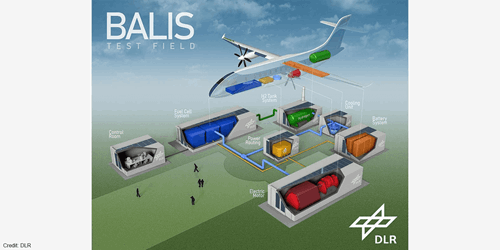News
DLR is testing 1.5 MW fuel cells for aircraft

In the BALIS project, the German Aerospace Center (DLR) is developing a fuel cell drive train for aircraft with an output of around 1.5 MW. This would make a regional aircraft with 40 to 60 seats and a range of 1,000 km possible.
Focusing on a fuel cell powertrain and unique test environment
The aim of the BALIS project is to develop and test a fuel cell powertrain with an output of approximately 1.5 MW. This would be enough to allow the development of a regional aircraft with 40 to 60 seats and a range of 1000 km. For this purpose, DLR is constructing a unique test facility.
It forms the necessary overall system, namely the complete hardware and the essential infrastructure, including the fuel cell system itself, the hydrogen tanks, the electric motor and the control technologies. This test environment is simultaneously complex and extremely flexible. It enables research and development under the most diverse conditions, requirements and guidelines applicable to the air transport sector.
“This test environment is complex and at the same time very flexible. It enables research and development work under the most varied of framework conditions, requirements and guidelines that apply in the aviation sector," DLR said in a statement.
“With BALIS, we create the basis for energy conversion technology, develop a first demonstration system in the 1.5 MW performance class, and work out an optimal operating mode," said André Thess, Director of the DLR Institute for Technical Thermodynamics. "The initial focus is on its use in air transport. However, such fuel cell systems can also be used in heavy-duty transport, for example in large commercial road vehicles, in trains or on ships."
“Such fuel cell systems can also be used in heavy-duty traffic, for example in large commercial vehicles on the road, in trains or ships,” said Thess.
The Federal Ministry of Transport is supporting the project with 26 MM euros.
Sound barrier at 1.5 MW—a new generation of fuel cell systems
Most fuel cells that are already commercially available have an output of 100 to 200 kW per module. To reach the megawatt range, however, it is not possible to combine any number of smaller systems. This is where the technology reaches its limits.
“There is a 'sound barrier' at 1.5 megawatts as far as the architecture and performance of current fuel cell system components are concerned," said Josef Kallo, a DLR expert on the use of hydrogen in air transport. "We want to exceed this limit and simultaneously bring together as few high-power fuel cell stacks as possible. To do this, we need novel approaches and new components, for example in optimized current-density distribution, voltage level, the handling of liquid hydrogen in large quantities and coupling to an overall propulsion system."

